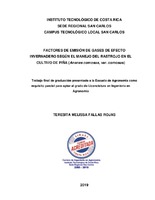Factores de emisión de gases de efecto invernadero según el manejo del rastrojo en el cultivo de piña (Ananas comosus, var. comosus)
Resumen
In Costa Rica, pineapple plantations are renewed every two years to start a new
production cycle, activity in which a large amount of stubble is generated that may emits gases that contribute to climate change (GHG). With the purpose to contribute in the development of a national GHG emission factor for pineapple stubble, this research was carried out in the El Tremedal S.A. farm, between August and December 2016. The experimental area involved 8400 m2 of a generalized blocks design, considering three types of plant stubble management after the second harvest: 1) stubble incorporated in green (RV), 2) stubble burned with chemical herbicide (RH), and 3) stubble burned with chemical herbicide plus fire (RH+Q). The emission flow of CH4 and CO2 was expressed in mg/m2/day for seven observations (every 15 days) and the accumulated in kg/ha. The results obtained generated an emission factor of both type gases on each type of management. Each management practice record lost of organic matter, carbon and nitrogen, except for the RV, which presented a minimum nitrogen gain. The emissions of CH4 and CO2 by type of stubble management showed high variability in the period evaluated. The emission factor determined that a stubble year release of GHG methane (CH4 ) in RV was 926 kg/ha, in RH it was 1592.30 kg/ha, and in RH+Q it was 1297.81 kg/ha. For the GHG carbon dioxide (CO2) in RV was 1541.76 kg/ha, for RH it was 2455.72 kg/ha and for RH+Q it was 2175.96 kg/ha.
Descripción
Tesis (Licenciatura en Ingeniería en Agronomía). Instituto Tecnológico de Costa Rica, Escuela de Agronomía, 2019.


